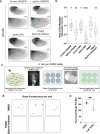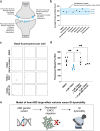Autism gene variants disrupt enteric neuron migration and cause gastrointestinal dysmotility
- PMID: 40050271
- PMCID: PMC11885846
- DOI: 10.1038/s41467-025-57342-3
Autism gene variants disrupt enteric neuron migration and cause gastrointestinal dysmotility
Abstract
The co-occurrence of autism and gastrointestinal distress is well-established, yet the molecular underpinnings remain unknown. The identification of high-confidence, large-effect autism genes offers the opportunity to identify convergent, underlying biology by studying these genes in the context of the gastrointestinal system. Here we show that the expression of these genes is enriched in human prenatal gut neurons and their migratory progenitors, suggesting that the development and/or function of these neurons may be disrupted by autism-associated genetic variants, leading to gastrointestinal dysfunction. Here we document the prevalence of gastrointestinal issues in patients with large-effect variants in sixteen autism genes, highlighting dysmotility, consistent with potential enteric neuron dysfunction. Using Xenopus tropicalis, we individually target five of these genes (SYNGAP1, CHD8, SCN2A, CHD2, and DYRK1A) and observe disrupted enteric neuronal progenitor migration for each. Further analysis of DYRK1A reveals that perturbation causes gut dysmotility in vivo, which can be ameliorated by treatment with either of two serotonin signaling modulators, identified by in vivo drug screening. This work suggests that atypical development of enteric neurons contributes to the gastrointestinal distress commonly seen in individuals with autism and that serotonin signaling may be a productive therapeutic pathway.
© 2025. The Author(s).
Conflict of interest statement
Competing interests: E.B. is a salaried employee of Citizen Health, with vested and unvested stock options. The remaining authors do not have any competing interests.
Figures




Update of
-
Autism gene variants disrupt enteric neuron migration and cause gastrointestinal dysmotility.bioRxiv [Preprint]. 2024 May 29:2024.05.28.593642. doi: 10.1101/2024.05.28.593642. bioRxiv. 2024. Update in: Nat Commun. 2025 Mar 06;16(1):2238. doi: 10.1038/s41467-025-57342-3. PMID: 38854068 Free PMC article. Updated. Preprint.
References
-
- McElhanon, B. O., McCracken, C., Karpen, S. & Sharp, W. G. Gastrointestinal symptoms in autism spectrum disorder: a meta-analysis. Pediatrics133, 872–883 (2014). - PubMed

